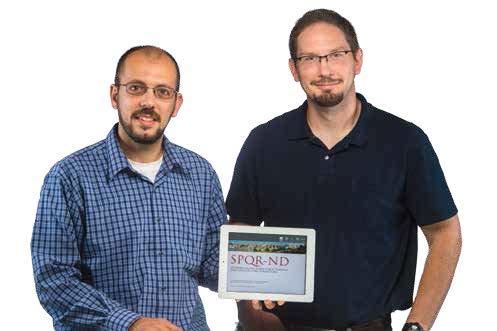
Most new iPad apps take weeks to be approved. The new app, SPQR-ND: Interpreting the Roman Forum Through Early Architectural Publications, was a two-day turnaround.
Proposed new apps are assigned to a reviewer, says Ibrahim Chaaban,IT consultant for architecture and application developer on the project. “They look at functionality and come back with recommendations. With ours, it was a two-day turnaround. There was nothing to fix. We submitted it on Tuesday, and by Wednesday at 7:45 p.m. it was in the app store.”
The app, available for iPad only, is free. Search for it by name, or just search “Roman Forum.”
The app was developed by Jennifer Parker, architecture librarian, Chaaban, and Adam Heet, digital projects specialist. The Center for Digital Scholarship’s Matt Sisk helped with mapping and geolocation. The project was a collaboration
between the Hesburgh Libraries, the Architecture Library and the School of Architecture’s Information Technology Division, and the Center for Digital Scholarship. App content was prepared by Notre Dame architecture students.
SPQR-ND allows students,scholars and the general public to study the monuments of Rome through early architectural
publications. These rare books, housed in the Architecture Library, have been digitized and (virtually) broken apart to allow the study of different historical interpretations of the monuments in the Forum sideby-side. The monuments are geolocated on a map, allowing one to understand their physical placement within the Forum.
The project started with the goal of providing access to plates from rare and antique archaeological publication—documenting monuments in the historic city center of Rome—for Notre Dame students studying abroad.
It became a way to combine historic methods of documentation and representation with mapping and mobile applications, providing a unique way to study the development of Rome.

Says Adam Heet, “You can’t take 15 or 20 rare books, pile them on the table and use Post-it notes, but this gives people the opportunity to use the books that way. We wanted to make sure we were offering things in the app that were useful—to allow scholars to compare and contrast multiple images from the books. We’re trying to provide content that scholars can use.”
The app showcases Notre Dame’s resources, Heet says, “but also lets people draw their own conclusions.”
Architecture students did a lot of the nuts-and-bolts work for the app, Heet adds. He digitized the books, “but just to present compiled information on who built it, when, why, and what it was made of, takes a fair amount of work.
“One thing we found is that when we were digitizing, we didn’t know we sometimes had 10 or more different images of the same structure, but each author called it something different. The attribution of the structure had changed. Was this the Temple of Concord, or did they just think Studying historic Roman architecture–virtually it was at the time? Students were very heavily involved in the research that needed to be done.”
The Colosseum offers a particularly good example of what the app offers. Using the sliders and going back and forth from the past to the present, “you really see so much difference,” Heet says. “You can see where the structure has crumbled, and where it was patched. It looked like this 400 years ago, but today a wall is totally gone, and other things
have been built onto it. We had to think about the monuments in the Roman Forum as being in kind of a state of flux.”
The SPQR app’s features include an interactive map of the Roman Forum along with a browsable list and descriptions of the monuments; photographs and multiple historic print representations of each monument; historical layered maps
and bibliographic information.
The app allows students studying in Rome access to rare books in the architecture library. “Students can walk through the Forum with an iPad. They—or anyone—can learn about it, even without a guide.”
Ideally, he says, the app in the future will be available in multiple languages, with 3-D views of the monuments—that will allow users to study high-quality scanned data stitched together to create virtual monuments.
Parker notes that the design is clean and user-friendly. “We can transfer the technology.”
What’s the next project? The three are working with other offices on campus, the Center for History and the Historic Preservation Commission to develop another app, “Architecture and Urbanism in South Bend, recreating South Bend as it appeared around 1925.
What’s exciting is the collaboration, says Parker. “People from all over campus can work together to create something great. And as a library, we’re providing access to traditional library resources through cutting-edge digital technologies.”
To read the rest of the October issue, visit news.nd.edu.
Originally published by Carol C. Bradley, NDWorks at architecture.nd.edu on September 25, 2014.

